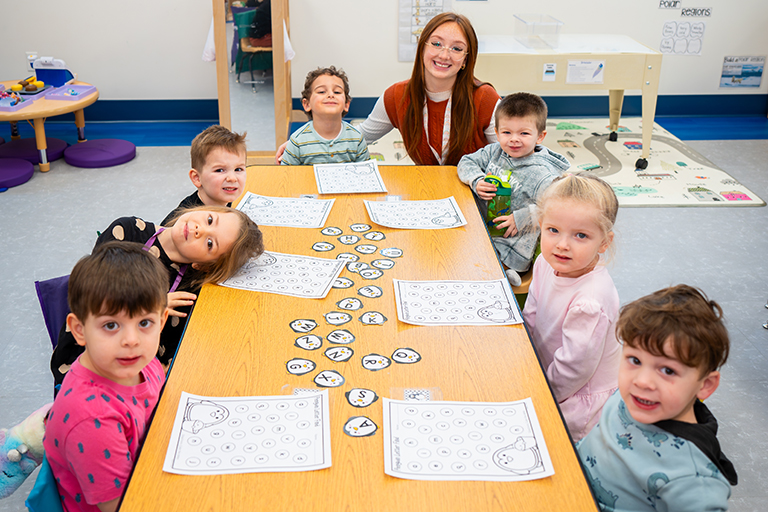
A significant distinction between our PK3 and PK4-5 classrooms lies in the level of child-led learning, offering tailored approaches to suit the developmental needs of each age group. In our youngest preschool classroom, the Jellyfish Room, we recognize that every child is unique, and their learning experiences should reflect their individuality. A significant distinction between our PK3 and PK4-5 classrooms lies in the level of child-led learning, offering tailored approaches to suit the developmental needs of each age group.
Our Jellyfish classroom embodies a child-led philosophy, fostering an environment where young minds are encouraged to explore, create, and learn at their own pace. This approach recognizes the importance of allowing children to take the reins in their learning journey, promoting self-discovery and a love for learning.
The PK3 classroom is thoughtfully designed to stimulate curiosity and engagement. Activity centers, featuring open-ended materials and age-appropriate toys, provide a canvas for children to express themselves creatively. Circle time is flexible, with a focus on responsive teaching, allowing educators to tune into the children’s interests and adapt activities accordingly.
In the PK3 setting, teachers act as facilitators, guiding and supporting rather than learning. This approach not only promotes independence but also allows educators to observe each child’s unique strengths and areas for growth, enabling personalized learning experiences.
For our younger learners, the child-led atmosphere minimizes stress and frustration. By giving them autonomy over their choices, we empower them to build confidence, resilience, and a positive attitude towards learning.
For younger preschoolers who may struggle with patience in teacher-led activities, the PK4-5 classroom provides a supportive environment. Educators guide children through challenges, emphasizing the development of foundational skills, including patience, cooperation, and problem-solving. As these preschoolers grow, so do classroom expectations surrounding engagement and willingness to follow teacher-led activities (i.e., short circle time and targeted learning activities) in a progression that aligns with each child’s developmental readiness.
As children transition to the PK4-5 classroom, the focus gradually shifts towards preparing them for the structure environment of kindergarten. Teacher-led activities become more prominent, emphasizing advanced skills and concepts necessary for a smooth transition.
In the PK4-5 classroom, we prioritize setting clear and age-appropriate expectations for engagement and participation. Children are encouraged to understand the importance of active involvement and active listening while recognizing and respecting individual learning styles. These skills not only aid academic learning but also enhance communication and social development—crucial components for success in modern kindergarten programs.
Despite the increased teacher guidance, play remains at the heart of the PK4-5 classroom. Play-based learning is woven into every activity, ensuring that children continue to engage in self-directed play, promoting social, emotional, and cognitive development.
The classroom layout is structured to accommodate both teacher-led instruction and child-directed play. Learning corners are designed to encourage exploration, while designated areas are set up for more structured group activities, fostering a balance between structure and creativity.
In the PK4-5 classroom, we instill a growth mindset, teaching children that challenges are opportunities for growth. Embracing this perspective, children are more likely to take risks and approach teacher-led activities with enthusiasm, understanding that the learning journey is a continuous process of improvement and discovery.
In conclusion, our main goal in the preschool program at Westview Child Care Center is to nurture comprehensive child development—cognitively, socially, and emotionally. We aim to strike a balance that honors each child’s individual pace, ensuring our preschoolers are well-equipped for the exciting adventures that lie ahead.
Posted on January 25, 2024
by Katy Holzer, Director